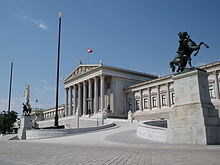Austrian Parliament Building
It was built to house the two chambers of the Imperial Council (Reichsrat), the bicameral legislature of the Cisleithanian (Austrian) part of the Austro-Hungarian Empire.
One of the building's most famous features is the Pallas Athena fountain in front of the main entrance, built by Carl Kundmann after plans from Hansen from 1898 to 1902; it is one of the city's most notable tourist attractions.
However, after the Austro-Hungarian Compromise (Ausgleich) which effectively created the Dual Monarchy in 1867, the Kingdom of Hungary received its own separate legislative body, the re-established Diet, and the original plan for two buildings was dropped.
The precursor to the present building was the temporary House of Representatives, located on Währinger Straße, off the newly laid-out Ringstraße boulevard.
It was erected within six weeks in March and April 1861 according to plans designed by Ferdinand Fellner, a famous Austrian theatre architect.
Completed on 25 April 1861 this temporary structure was opened by Emperor Franz Joseph I of Austria, and soon afterwards mocked Schmerlingtheater, after Minister Anton von Schmerling.
In his famous decree Es ist Mein Wille of 1857, Emperor Franz Joseph I had laid down plans for the Ringstraße to replace the old city walls.
The parliament building was supposed to feature prominently on the boulevard, in close proximity to Hofburg Palace and the Vienna City Hall.
After studying rival proposals, the Imperial Commission chose the plan by Theophil Hansen, who could rely on his drafts for Zappeion Hall in Athens.
The joke on the Viennese streets was that Athena was so disgusted by the political infighting that she deliberately turned her back to the building.
From 21 October 1918, the remaining German-speaking deputies convened in a "Provisional National Assembly", initially at the Palais Niederösterreich, from 12 November onwards in the Parliament Building.
The parliament was incapacitated, when on 4 March 1933 Chancellor Engelbert Dollfuß took the occasion of a parliamentary law quarrel to cease its function, the first step to the introduction of his Austrofascist dictatorship.
By the imposed "May Constitution" of 1934, the Parliament Building became the seat of the Bundestag, the formal legislature of the Federal State of Austria.
It was in the old Abgeordnetenhaus Chamber that the new Chancellor Karl Renner on 27 April 1945 declared the rebirth of an independent Austria, backed by Soviet troops.
Hansen worked at that time in Athens and was recruited by the Greek-Austrian magnate Nikolaus Dumba, who was on the committee for constructing a new parliament building.
The white, sturdy stone was perfect for von Hansen's aims, since the building blocks for the façade and statues could be made to look like those used in ancient Greece.
Over the decades, with increased air pollution, the marble has proved remarkably resilient, stronger than its famous counterpart from Carrara.
The Athena Fountain (Pallas-Athene-Brunnen) in front of the Parliament was erected between 1893 and 1902 by Carl Kundmann, Josef Tautenhayn and Hugo Haerdtl, based on plans by Baron von Hansen.
The middle axis from east to west is divided into an entrance hall, vestibule, atrium, peristyle, and two large rooms at the far end.
For the interior decoration, von Hansen used Greek architectural elements such as Doric, Ionic and Corinthian pillars, and in the two rooms Pompeii-style stucco technique for the walls.
The main entrance at the portico is an exact copy of the gate of the Erechtheion on the Acropolis of Athens, fitted with a bronze portal.
It runs along the corridor, continuing into the atrium, and contains an allegorical depiction of the blessing of Peace, of the civic Virtues, and of Patriotism.
Representing the motto "Goods and Blood for thy country" (Gut und Blut furs Vaterland), warriors swear loyalty and women bring offerings.
Hansen also wanted to have the hall used by the monarch for the State Opening of Parliament and the Speech from the Throne, similar to the British tradition.
It is used today for committee meetings and hearings on financial, state budget, and audit court matters by the National Council, thus being presently named the Budgetsaal.
The statues show historical persons such as Numa Pompilius, Cincinnatus, Quintus Fabius Maximus, Cato the Elder, Gaius Gracchus, Cicero, Manlius Torquatus, Augustus, Seneca the Younger and Constantine the Great.
Many politicians started their career as deputies, such as Karl Renner, later chancellor and president of Austria, and Leopold Kunschak, later conservative leader.
These include: In Austria In Czechoslovakia in Poland in Italy in Yugoslavia in Ukraine The Austrian Imperial Council (Reichsrat) was the recruiting school for central and southeastern democracy and socialism.
Green was also said to have a soothing effect, something that apparently weighed in the decision, considering the tumultuous debates the building had to endure before the two World Wars.
The United Nations Educational, Scientific and Cultural Organization (UNESCO) classifies the inner city of Vienna, including the Ringstraße and thus the Parliament Building as a World Heritage Site.














